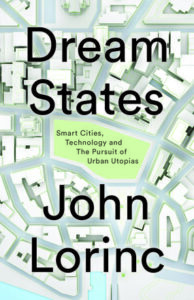Far from the disorderly world of big city streets, Mart Suurkash, the CEO and founder of Bercman Technologies, demonstrated a working prototype of the firm’s “smart pedestrian crosswalk” before a small crowd of onlookers gathered in a trade show booth in November 2019. It was hosted by the Government of Estonia at the sprawling annual smart city trade show that was held in Barcelona each year until the pandemic forced the event to go virtual.
I’d travelled to the Catalonian capital to spend the week talking to presenters, listening to smart city sales pitches, and checking out demos. The event took place in Barcelona’s cavernous suburban convention centre, a three-hall affair with breakout rooms, snack bars, and theaters. Like most industrial trade shows, the floor felt a bit like a mini indoor city, the brightly lit aisles crowded with lanyard-wearing attendees carrying tote bags full of brochures.
Like a modern-day souk, touts worked the edges of their booths, encouraging people to sit for a presentation, test some gadget, take a business card. The logos of the big sponsors—for 2019, Cisco and Mastercard—were festooned on walls and way-finding maps around the convention centre.
Given the particular focus of this event, the organizers and demonstrators had doubled down on the urban motif. The event had its own neighborhoods, complete with “cafés” and street furniture. Several regional and state governments had their own districts. Tel Aviv’s booth was designed to look like a bar, complete with pulsing EDM and free beer. I noticed that besides an appearance on one panel discussion, Sidewalk Labs was nowhere to be seen.
Cities are highly complex “systems of systems” filled with human beings who don’t necessarily respond rationally or predictably to the world around them.Bercman’s device looked exactly like crosswalk signs throughout Europe: a post supporting a square sign with the universal symbol of a pedestrian crossing a street. What makes it “smart,” as he explains, is an assembly of digital devices stowed inside the sign: high-tech motion detectors aimed in all directions that are programmed to calculate the velocity of vehicles approaching the crosswalk to determine whether vehicles are slowing safely when someone is crossing.
The software included a “machine-learning” algorithm that allows the detector to learn and then anticipate traffic patterns so it can “optimize” for cars moving through a particular location. Bercman’s smart crosswalk was also fitted with wireless transmission capabilities that will someday automatically send notifications to fast-moving, connected vehicles, alerting them to brake right away. When the cross-walk signal detects danger, it flashes and beeps.
The start-up, which is based in Tartu, Estonia’s second largest city and a hub of tech development, wanted to find solutions to rising pedestrian fatality rates, as well as the eventual advent of self-driving cars. “We thought these vehicles might need some help from smart infrastructure,” Bercman said.
As of 2020, the smart crosswalk was still in development. Suurkash told me that in real-world testing, about a third of the warning signals turned out to be false alarms.
As it happens, the company’s device was also fitted with sensors measuring air quality, traffic flow, and pedestrian volumes, as well as digital cameras designed to identify license plates. The sign, he said, “is just one part” of a smart city “ecosystem.”
*
Since the 1960s, the revolution in information and communications technologies (ICT)—from early mainframe computers and cable TV to 5G smart phones and high-bandwidth fibre optic cable—have transformed cities into densely networked hubs where digital interactions are woven virtually into every facet of urban life.
Smart city technology, a by-product of the ICT revolution, is a broad and amorphous catch-all category. One common denominator is that these technologies are designed to gather and synthesize digital data generated by all sorts of urban activity—GPS-equipped transit vehicles, hidden patterns in huge databases of building inspection records, power consumption trends, online resident feedback to planning approvals, and so on.
Some experts advocate for “intelligent civil infrastructure,” which proposes extensive deployments of wireless sensors attached to everything from roads and bridges to water mains, and which are designed to detect system failures even before they can be noted by inspectors (Goldsmith, Gardner, and Jamieson 2021). The ostensible goal is to put all that data to work to address a range of urban problems—”optimizing,” as smart city tech insiders say.
One can think of smart city systems as technologies that watch or listen to what’s happening in urban areas and then transform those observations into action. However, while we live in a hyper-accelerated world of high-speed communication, smart city technologies, to be effective, must overcome both the so-called latency problem—the lag between gathering ground-level information and acting on it—and the bugs or viruses that invariably find their way into any computer-driven system.
While we live in a hyper-accelerated world of high-speed communication, smart city technologies, to be effective, must overcome both the so-called latency problem.These systems, observes Eric Miller, a professor of civil engineering and director of the University of Toronto’s Transportation Research Institute, “are about creating more and better feedback loops, on the assumption that it will lead to better outcomes.” But, he adds, cities are highly complex “systems of systems” filled with human beings who don’t necessarily respond rationally or predictably to the world around them. “The central question,” Miller observes, “is the interaction between technological systems and people systems.”
*
Smart city systems are built with a diverse and ever-growing range of technological building blocks: hardware, software, cloud-based data warehouses and cellular networks, artificial intelligence algorithms, etc. The components run the gamut from smart phone apps and cheap sensors to multi-million-dollar transportation control hubs. Some observers have used the term “everyware” to describe their ubiquity.
While a lot of smart city tech is designed for and purchased by local or regional governments seeking to digitize a wide range of services, these systems can also be found in health care, education, and utilities, as well as private sector environments, such as “smart” office buildings.
Many are focused on security and urban mobility applications, while others—e.g., mapping, short-term rental or recommender apps—aren’t geared at the municipalities per se but turn out to have far-ranging implications for the ways in which cities actually function. Still others are built using various forms of information released by municipalities through open data portals—everything from zoning bylaws and property lines to the GPS signals on transit vehicles.
*
The building blocks of smart city systems, these very inexpensive, compact (fist-sized or smaller) devices can be installed on all manner of objects ranging from utility poles and buses to water mains and bridges. They can be designed to gather readings on air quality, vibrations, passenger loads, traffic volumes, or leaking pipes.
Sensors are fitted with small radio transmitters to send readings wirelessly, with the signals ultimately shunted to control centers that monitor water systems or local utilities and use this real-time data to manage problems.
In Philadelphia, for example, the city a decade ago installed “Big Belly” waste bins equipped with GPS-enabled sensors that detect when they need to be emptied. Carlton Williams, Philadelphia’s street commissioner, told me the devices allow the municipality to route garbage trucks more efficiently—i.e., they pick up only from full bins—and have slashed the number of crews on some routes, with a $600,000 per year savings. The reduction in the number of trucks has also reduced congestion. “We think it’s a huge success,” he says.
Tiny sensors are now embedded in all sorts of privately purchased consumer goods and electronics, such as smart thermostats, wearable continuous glucose monitors, or fitness trackers in products like Fitbit or Apple Watches. These devices are creating entirely new types of data-driven relationships between the private realm of the home or a business and the wider public realm of the city.
Such applications also raise hard questions about privacy protections and the potential misuse of such sensors for surveillance or marketing purposes.The sensors in smart thermostats, for example, provide continuous temperature readings that are sent wirelessly to a central control device. But some smart heating systems are also tethered electronically to local utilities, which aggregate all this information and use it to manage their energy output or even remotely adjust heating or cooling levels in customers’ homes in response to peak period demand.
Some health sensors wirelessly connect people with conditions like diabetes to medical practitioners as well as with smart-phone apps that can predict changes in insulin levels. A 2018 research study of more than 33,000 diabetics, some with continuous glucose monitors and others without, showed lower health care costs and fewer hospital admissions among those fitted out with these wifi-enabled devices.
Fitness trackers, in turn, reveal another type of interplay between personal health and public amenities. The enormous popularity of the 10,000-steps fitness regimen has prompted many people to begin taking regular walks in their neighborhoods or local parks. The additional pedestrian (and cycling) activity is unquestionably a positive development, and could even serve as a prompt to local governments to build out pedestrian/cycling infrastructure, perhaps even, as some researchers have argued, by leveraging the GPS data generated by these trackers (and smart phones generally) to determine where they could be adding or expanding sidewalks or creating new trails.
Yet such applications also raise hard questions about privacy protections and the potential misuse of such sensors for surveillance or marketing purposes.
*
The presence of hundreds of thousands of closed-circuit television (CCTV) cameras on city streets around the world, as well as all sorts of buildings and other public spaces, is nothing new, but these devices have become smaller, cheaper, less static, and more prevalent in a range of settings. For example, digital doorbells with digital cameras, some made by Google and Amazon, allow homeowners to use their smart phones or even laptops to watch for porch pirates or keep an eye on what’s going on on the street.
The use of facial recognition systems, as well as related software that can identify an individual’s gait, has become increasingly prevalent in some regimes. In China, ubiquitous CCTV surveillance and advanced facial recognition software have been extensively deployed as part of the Communist government’s security and intelligence operations. Some of these are developed by private firms like Clearview, a smart-phone-based facial recognition system, and Sense Time, a Chinese AI company whose investors include Alibaba Group and Qualcomm, a U.S. chip maker.
In many North American cities, police are equipped with body-worn cameras and dash-cams that record interactions and upload video for temporary storage. Drones, increasingly inexpensive and deregulated, are fitted out with high-res video. These can be used for everything from real-estate listings to missing person searches and the monitoring of cracks or energy losses on the outsides of high buildings. In the U.K., police drones use facial recognition software to assist with such missions.
Specialized cameras are also being affixed to vehicles for use in mapping applications that go well beyond Google’s street view. For example, Mobileye, a publicly traded Israeli firm owned by Intel, works with vehicle manufacturers to install specialized cameras on the front windshields of trucks and buses. The cameras record whatever is on the street, with the streaming video continuously uploaded to a cloud-based mapping database. These maps can be accessed wirelessly by autonomous vehicles that need real-time information about what is on the road.
But a rapidly spreading backlash against surveillance-oriented technologies, including those embedded in popular social media platforms, has prompted some global technology firms to halt or discontinue their facial recognition programs, among them IBM, Microsoft, and Meta/Facebook, which deleted facial data on a billion users in late 2021. “The many specific instances where facial recognition can be helpful need to be weighed against growing concerns about the use of this technology as a whole,” a senior Meta artificial intelligence executive wrote of the decision on the company’s blog.
*
The collection of objects and sensors with wireless connections to the internet constitutes the “internet of things” (IoT) and includes devices as diverse as Bluetooth-connected electric toothbrushes with accompanying app, electric water heaters, smart fridges, etc.
In recent years, tech giants like Cisco and IBM have estimated the number of such devices, which includes cell phones. The figures, according to Barcelona-based IoT privacy and information policy researcher Gilad Rosner, are staggering: 20 billion to 50 billion globally, as of 2020, although the numbers vary widely depending on what’s included. The actual figure, he told me over Zoom, “is difficult to pinpoint.”
Smart city systems are increasingly built on a digital foundation that includes an extensive deployment of wifi-enabled sensors that are connected to the IoT. These networks may allow works officials and structural engineers to remotely monitor vibrations on major bridges or property managers to track mechanical systems in smart office buildings.
According to an August 2020 survey of fifty global cities by IoT Analytics, the most prevalent urban applications include connected public transit, traffic, flood, and weather monitoring, video surveillance, street-lighting and air quality sensors.
Yet IOT in public space raises critical issues about security—are these tiny and inexpensive devices linked wirelessly to extensive digital networks vulnerable to hacking?—as well as privacy, or what Rosner describes as the “right to obscurity.” “The issue is surveillance,” he says. “The more sensors, the more surveillance.”
Although some smart technologies—video-conferencing, for example—have solved practical problems and seem to have become permanent fixtures in our society, others are still in development, promising easy solutions that don’t quite fit the untidy reality of busy cities.
Shoshana Saxe, an assistant professor of civil engineering at the University of Toronto, cites an infrastructure monitoring system developed jointly by NASA and the University of Bath. The idea is to use remote wireless sensing devices on satellite radar to detect subtle structural vibrations on bridges that could indicate the presence of worsening weaknesses. officials and control systems can monitor the sensors for signs of trouble.
But, as she notes, the problem with this idea is its reliance on digital devices, wireless networks, and the electrical grid. What would happen, she asks, if the power goes out or the sensors fail to pick up the vibrations created by a potentially catastrophic crack? Other smart city watchers have also warned about the risks of what Anthony Townsend describes as “buggy and brittle” technologies.
Smart cities, Saxe wrote in a widely shared 2019 New York Times column, “will be exceedingly complex to manage, with all sorts of unpredictable vulnerabilities. There will always be a place for new technology in our urban infrastructure, but we may find that often, “dumb” cities will do better than smart ones.”
She observes that ordinary consumer electronics—e.g., cell phones or kitchen appliances kitted out with some kind of digital functions—become obsolete rapidly, and smart city tech will be no different.
“Rather than chasing the newest shiny smart-city technology,” Saxe warned, “we should redirect some of that energy toward building excellent dumb cities—cities planned and built with best-in-class, durable approaches to infrastructure and the public realm…Tech has a place in cities, but that place is not everywhere.”
___________________________________

Adapted and excerpted from Dream States: Smart Cities, Technology, and the Pursuit of Urban Utopias by John Lorinc. Copyright © 2022. Available from Coach House Books.



